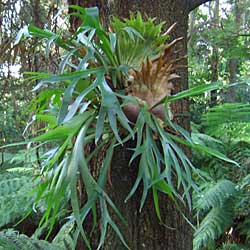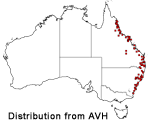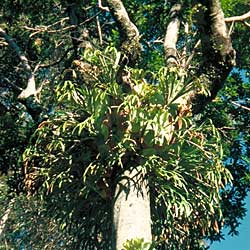Platycerium bifurcatum
 |
 |
|
Elkhorn Fern
Platycerium bifurcatum (Cav.) C.Chr.
Platycerium bifurcatum, the Elkhorn fern, occurs naturally in New Guinea, and along the coasts of Queensland and New South Wales. It is cultivated in many countries, it has become naturalised (that is, it has spread into the wild) in Florida, and it has been listed as an environmentally invasive species in Hawaii. It belongs in the family Polypodiaceae, which has 10 genera and 26 species in Australia.
 The
Elkhorn fern is an epiphyte, growing on the trunks and branches of trees. Each
plant is composed of a mass of plantlets. A plantlet consists of a nest leaf
12-30 cm wide, lying against the bark of the host tree. The nest leaves of neighbouring
plantlets overlap one another. The nest leaves become brown and papery with
age, and do not produce spores (they are sterile). Fertile fronds 25-90 cm long
protrude from each plantlet. Each frond divides into two segments a number of
times along its length. Spores are produced on the undersurface of the end segments
of each frond. The spore producing areas are coloured tan brown, and have the
texture of velvet cloth.
The
Elkhorn fern is an epiphyte, growing on the trunks and branches of trees. Each
plant is composed of a mass of plantlets. A plantlet consists of a nest leaf
12-30 cm wide, lying against the bark of the host tree. The nest leaves of neighbouring
plantlets overlap one another. The nest leaves become brown and papery with
age, and do not produce spores (they are sterile). Fertile fronds 25-90 cm long
protrude from each plantlet. Each frond divides into two segments a number of
times along its length. Spores are produced on the undersurface of the end segments
of each frond. The spore producing areas are coloured tan brown, and have the
texture of velvet cloth.
The easiest way to propagate P. bifurcatum is to remove a plantlet and then tie it to the desired new location. A large old knife, or a thin flat trowel, may be used to remove a plantlet from the rest of the plant. The implement should be inserted beneath the membrane of a plantlet and then used to prize the roots of the plantlet from the other plantlets. The plantlet may then be tied to its new location with lengths of cloth or stocking. If the new plant is required to be of a large size, then a number of plantlets can be removed together from a large P. bifurcatum plant.
Platycerium bifurcatum may also be propagated from its spores. To collect the spores, place the part of a frond that is producing spores in a brown paper bag. Leave the frond in the bag until there is brown dust in the bag, which are the spores. Fill a plastic or terracotta pot with peat moss, and pour boiling water through the peat moss to sterilize it. Immediately place a glass or plastic sheet over the pot to keep it sterile. Once the peat moss has cooled down, spread the spores evenly over the surface of the peat moss, then immediately replace the glass or plastic sheet over the pot. Stand the bottom of the pot in an ice cream container with a shallow layer of water, and place the pot and container in a warm position receiving indirect sunlight. Once the spores have germinated, a green scum will initially appear over the surface of the peat moss. After a period of weeks to months, the fronds of the Elkhorn fern will begin to appear and the glass cover of the pot can be removed. Once the new plants have grown larger, they can be transferred to a tree trunk.
P. bifurcatum plants require a shady area to grow in, and need to be kept moist. They are not prone to attack from many pests and insects, but may be preyed upon by scale bugs and mealy bugs. These pests may be removed from the plant by scratching them off. Ladybirds will eat these pests, and so may help to control them.
Text by Robert Mason (2004 Student Botanical Intern)
Derivation of the name: Platycerium bifurcatumPlatycerium - is derived from the Greek words platys meaning "flat" and ceras meaning "a horn", referring to the shape of the fronds. bifurcatum - means to fork into two branches, again, referring to the shape of the fronds. |
References
Pemberton R.W., 2003, "The common staghorn fern, Platycerium bifurcatum, naturalises in Southern Florida", American Fern Journal, vol. 93, no. 4, pp. 203-206.
Jones D.L., Goudey C.J., 1981, Ferns in Australia, common, rare and exotic, Reed Books Pty. Ltd, Frenchs Forest NSW, p. 20.
Van der Mast S., Hobbs J., 1998, Ferns for New Zealand gardens, Godwit Publishing Ltd, Auckland, pp. 26-27.
Wilson P.G., "Polypodiaceae", in Harden G.J., (ed.), 1990, Flora of NSW, vol. 1, New South Wales University Press, Kensington NSW, pp. 38-39.
Perrin D., 1988, Dictionary of botanical names: Australian plant names. Published by Don Perrin Bushland Stickers, Kippa Ring, pp. 9, 12, 40.
![An Australian Government Initiative [logo]](/images/austgovt_brown_90px.gif)


